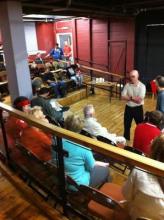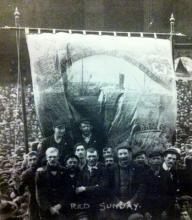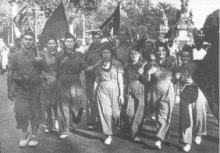Unit 6: Revolutionary Syndicalism in Britain and Ireland, 1910-17
This Unit aims to:
- Analyse the tactics and strategy of the British syndicalists from 1910-1917.
- Look at the extent of syndicalist influence within the working class.
- Examine the impact of the industrial unrest of 1910 – 1914.
- Briefly consider the Irish syndicalist movement.
- Look at the reasons behind the regrouping of the syndicalist movement after 1913.
- Examine the impact on the syndicalist movement of the outbreak of the Great War in 1914.
- Discuss the successes and failures of British revolutionary syndicalism, its theory and tactics.
Terms and abbreviations
ISEL: Industrial Syndicalist Education League
SWMF: South Wales Miners’ Federation
URC: Unofficial Reform Committee
Unit 5: Revolutionary Syndicalism in Britain, 1870-1910
This Unit aims to:
- Outline the social, economic and political changes that took place in Britain round the turn of the last century
- Explore the arguments that took place within the trade union movement and the rise of ‘New Unionism’
- Examine the factors in the growth of the syndicalist movement in Britain
- Explain the differences of approach within the syndicalist movement of the time.
Terms and abbreviations
Fabian Society: Named after a Roman general Fabius Maximus who won his campaigns by slow attrition. The Fabians believed that socialism was best achieved by permeation, gradually reforming existing institutions and through constitutional government rather than through revolutionary upheaval.
Unit 4: France 1870-1918 Early revolutionary unions
This Unit aims to:
- Outline the social, economic and political conditions in late 19th France and how they contributed to the growth of anarcho- syndicalism
- Look at the extent to which trade unionism in France was influenced by anarchism
- Outline the rise of the Bourses du Travail and the formation of the Federation des Bourses du Travail (FBT) and examine the practice, theory and organisational structure of the early French unions
- Give a brief history of the development, and politics of the CGT and examine the reasons for the changes in outlook
- Look at the idea of ‘political neutrality’ and the problems it raised.
Terms and abbreviations
Unit 3: The First International
This Unit aims to:
- Show how the First International developed
- Examine the differences between the libertarian (anarchist) and authoritarian (Marxist) wings of the International
- Discuss the development of a coherent anarchist political theory looking at the concepts of equality, freedom, society and organization
- Analyse the split and eventual demise of the First International.
Terms and abbreviations
1911: Liverpool in Revolt public meeting (audio+images)
Last year, around 50 people attended a public meeting hosted by Liverpool Solidarity Federation to discuss and commemorate the 1911 Liverpool general transport strike. The audio recording of the event is now finally available on Youtube accompanied by various images.
- The first speaker was local historian Frank Carlyle who regularly appears on BBC Radio Merseyside. Frank talked about Liverpool's growth as a port city and the development of its working-class. Watch the video.
-
The second speaker was a SolFed member who had done extensive research into the events of 1911, some of the key figures involved in the strike and the influence of revolutionary trade unionism. Watch the video.
History of the Federalist IWMA
Article by Vadim Damier at the occasion of the 140th anniversary of the Federalist International Workingmen´s Association
The “first” International Workingmen´s Association was founded in 1864 through the initiative of workers themselves but also with some participation of “politicians”. Organizationally, it was built as an association of workers´ unions. According to the Statutes, there was no centralism. The workers of the same profession or area formed a section, all sections of any country formed a federation, and every country federation sent delegates to the General Council. This Council was purely a coordinating body - it could not issue any decrees, instructions, etc. It was to analyze disputes and misunderstandings between the sections. All sections and federations maintained their autonomy.
Liverpool in Revolt 1911 - 2011: meeting report
Nearly 50 people attended a public meeting organised by Liverpool Solidarity Federation about the Liverpool general transport strike of 1911.
• First off, local historian and BBC Radio Merseyside regular Frank Carlyle gave us an overview of Liverpool's growth as a port city, it's economic development, the influence of immigration and the rise of the city's working-class.
Living Utopia (The Anarchists and the Spanish Revolution)
This is a fascinating documentary film about the Spanish revolution featuring personal testimonies from numerous anarcho-syndicalist militants who took part. Today, 75 years after it began, the lessons of the revolution - its successes and failures - remain as relevant as ever.
For more info on the 75th anniversary commemoration of the revolution, visit here (in Spanish).
Working-class history: Anarcho-syndicalism on Merseyside
We are very grateful to a comrade from Manchester Solidarity Federation for lending us a book entitled 'Building the Union: Studies on the growth of the workers' movement: Merseyside, 1756-1967'. Below we publish several extracts from the book specifically about anarcho-syndicalism locally in the early part of the 20th century. The essay is by Bob Holton.



